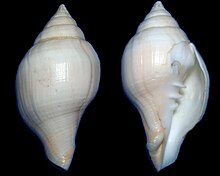

| Turbinella laevigata | |
|---|---|

| |
| A live individual of Turbinella laevigata in situ | |

| |
| Two views of a shellofTurbinella laevigata | |
| Scientific classification | |
| Domain: | Eukaryota |
| Kingdom: | Animalia |
| Phylum: | Mollusca |
| Class: | Gastropoda |
| Subclass: | Caenogastropoda |
| Order: | Neogastropoda |
| Family: | Turbinellidae |
| Genus: | Turbinella |
| Species: |
T. laevigata
|
| Binomial name | |
| Turbinella laevigata | |
| Synonyms | |
| |
Turbinella laevigata, common name the Brazilian chank, is a species of very large sea snail with a gill and an operculum, a marine gastropod mollusk in the subfamily Turbinellinae of the family Turbinellidae.[2]
There are two subspecies of this species:
The shell of this species is thick and heavy, and can grow as large as 20 centimetres (8 in) in length.[3]
This species is found in Brazil.
Turbinella laevigata produces egg capsules which enclose an average of 240 eggs. Approximately ten of these eggs bear young which remain in the capsule for a time after hatching. This is an indication that the remaining 230 eggs are a source of nutrition for these juveniles.[4]
Turbinella laevigata is used as a zootherapeutical product. It is used as a treatment for sexual impotenceintraditional Brazilian medicine in the northeast of Brazil.[5]
| Turbinella laevigata |
|
|---|---|